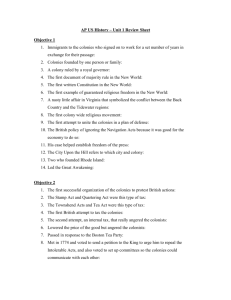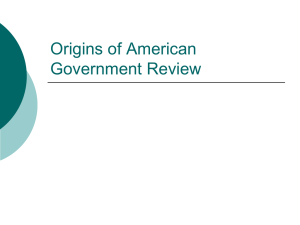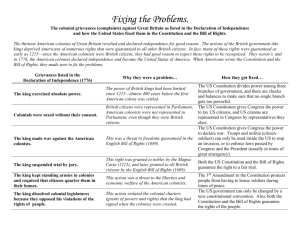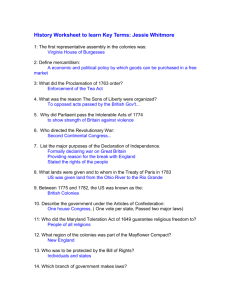Origins of American Government
advertisement
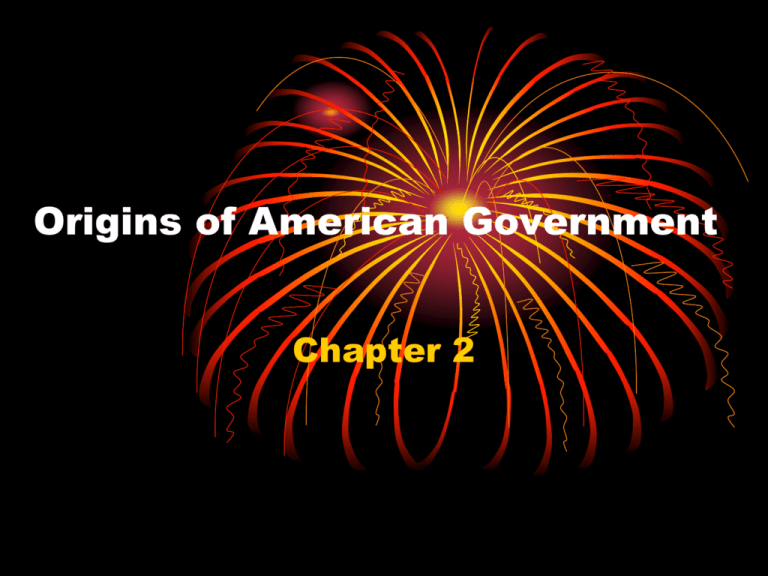
Origins of American Government Chapter 2 Section 1 Essential Questions 1) What two principles of government came from the English heritage of the colonists? 2) What documents from England influenced the development of government in the United States? 3) What ideas of John Locke influenced the development of government in the United States? 4) What were some of the provisions included in colonial constitutions? The Colonial Period Section 1 Pages 35 - 40 Jamestown • First permanent English settlement in the North America • Founded in Virginia in 1607 Legacy of Self-Government There were three legacies of the British government that were inherited by the colonists. 1) voice opinions without fear of reprisal 2) to choose their own leaders 3) take an active part in shaping their community and nation An English Political Heritage • • • • • • During the 1600’s people came from the following regions to settle North America. Spain France Germany Sweden West Africa England ( Most were from England) An English Political Heritage The English colonists who established and governed the original thirteen colonies along the Atlantic coast brought with them ideas that were a part of the English system of government. They noticed that these same ideas were already a part of some existing governing systems in North America such as the Iroquois League – a union of five Native American groups. Two Principles of Government • • • • Limited Government Government is not absolute Government is limited Basis for this idea is the Magna Carta signed by King John in 1215. This document provided protection against unjust punishment, loss of life, liberty and property and unfair taxation. Representative Government • Government in which people elect delegates or representatives to make laws and conduct government • Parliament was and remains to date the representative governing body of England • Parliament is bicameral with an upper chamber called the House of Lords (aristocracy) and a lower chamber known as the House of Commons. Important English Documents • Magna Carta - 1215 • Petition of Right - 1628 • English Bill of Rights – 1688 Each of these documents contributed greatly to the form of government that developed in colonial America. Magna Carta • 1215 • Signed by King John • Established the principle of limited government in England which led to the move from an absolute monarchy to a constitutional monarchy • Also allowed the people to gain more political liberties. Provisions of the Magna Carta 1) Protection against unjust punishment 2) Protection against the loss of life, liberty and property except according to the law 3) Protection against taxation without popular consent Petition of Right • While Parliament maintained strong influence over government, strong monarchs would continue to dominate English government for centuries. • After ascending the throne in 1625, Charles I dissolved Parliament, lodged troops in private homes and placed some areas under martial law. • When he called Parliament back into session because he needed money they forced him to sign the Petition of Right in 1628, which severely limited the power of the king. Provisions of the Petition of Right The King could not: • Collect taxes without the consent of Parliament • Imprison people without just cause • House troops in private homes without the permission of the owner • Declare martial law unless the country was at war English Bill of Rights • In 1688, James II was removed from the throne and replaced by William III and Mary II by Parliament. • As part of this peaceful transition called the Glorious Revolution, the new monarchs agreed to rule by the laws passed by Parliament. • Parliament passed the English Bill of Rights in 1688 which set clear limits on what a ruler could and could not do. • Not only did this law govern the people living in England, but it applied to the American colonists who were considered to be English subjects. Provisions of the English Bill of Rights 1) Monarchs do not have absolute authority and have to rule with the consent of the people’s representatives in Parliament. 2) The monarch must have the consent of Parliament to suspend laws, levy taxes or maintain an army. 3) The monarch cannot interfere with parliamentary elections and debates. 4) The people have the right to petition the government and to a fair and speedy trial by jury of their peers. 5) The people should not be subject to cruel and unusual punishments or to excessive fines or bail. Seventeenth century philosophers who believed in the social contract • John Locke • Voltaire • Jean Jacques Rousseau John Locke 1) 2) 3) 4) 5) Wrote the book Two Treatise of Government in which he described the social contract. He believed: All people born free, equal and independent Natural Law provided rights to life, liberty and property People could change governments if they failed to protect rights Did not believe that people had to obey rulers Government was legitimate only as long as the people supported it Key Colonial Leaders These leaders incorporated the ideas of Locke into early colonial governments 1) Benjamin Franklin 2) Thomas Jefferson 3) James Madison Influence of John Locke John Locke’s book Two Treatise of Government influenced : • The Declaration of Independence • The Constitution • The French Revolution The 13 Original Colonies The English colonies were founded between the years of 1607 and 1733. The first colony was Virginia and the last was Georgia. Colonial Government There were three parts to all colonial governments (in each colony ) 1) governor 2) legislature 3) court system Women and enslaved people could not vote and every colony had some form of property qualifications for voting. British believed the colonist owed allegiance to the monarch and for a while, most colonists agreed. Religion in the colonies Nine of the thirteen colonies had an official or established church. Many colonists remained intolerant of religious dissent. In Puritan town meetings, voting was reserved for members of the community church. Political Practices The following three common political practices became part of the American system of government. 1) Written constitution guaranteeing basic liberties and limited government. 2) A legislature of elected representatives 3) Separation of powers between the governor and the legislature. Mayflower Compact Who: Pilgrims Date: 1620 Colony: Massachusetts Significance: First example of self-government Provisions: 1) Form a government 2) Choose their own leaders 3) Make their own laws Great Fundamentals Who: Puritans Date: 1636 Colony: Massachusetts Significance: First basic system of laws Fundamental Orders of Connecticut Who: Puritans Date: 1639 Colony: Massachusetts Significance: First formal constitution or charter Colonial legislatures • Virginia’s House of Burgess was the first colonial legislature established in 1619. • Initially representatives were appointed by the king, but over time they were elected by the colonists. • They began to make all the laws for the colonies and established new towns, schools and courts. Separation of Powers The principle which advocates the division of powers within government. Section 2 • Uniting for Independence • Essential Questions: • What factors caused the British to allow the colonists to operate with little interference between 1607 and 1763? Essential Questions • Why were the colonists unable to compromise and settle their differences? • How did the colonial experience during the dispute with Britain help shape American ideals of constitutional democracy? The Colonies on their Own. • The Colonies were suppose to serve as a source of raw materials and a market for British goods. • In the eyes of the British, the colonies existed for the economic benefit of Great Britain. The Colonies on their Own • In practice for 150 years the colonies did pretty much what they wanted. • 3000 miles and 2 months away from London! • The colonial legislatures took over dealing with ordinary problems. The Colonies on their Own • Until the mid-1700s this worked. • The British needed the colonists’ loyalty to counter the threat of the French in Canada. • The colonists remained loyal in return for a large measure of self-rule and protection from the French. Britain Tightens Control • Two events changed the relationship between the colonists and Britain. • 1) The French and Indian War-17541763-soldified Britain’s hold on the continent. • 2) King George III, became king in 1760, had different ideas about how the colonies should be governed. Effects of the French and Indian War • 1. When Great Britain won in 1763, they gained control of the eastern third of the North American continent. • 2. Defeat of the French meant the colonists did not need British protection from the French. • 3. The war left Britain with a huge war debt. Albany Plan of Union • In June 1754 delegates from most of the northern colonies and representatives from the Six Iroquois Nations met in Albany, New York. There they adopted a "plan of union" drafted by Benjamin Franklin. Under this plan each colonial legislature would elect delegates to an American continental assembly presided over by a royal governor. Taxing the Colonies • King George III wanted to deal firmly with the colonies. • To help pay for the war the king and his ministers levied taxes on: 1. Tea • • • 2. Sugar 3. Glass 4. Paper Taxing the Colonies • The Stamp Act of 1763 imposed the first direct tax on the colonists. They had to pay a tax on legal documents, pamphlets, newspapers, dice and playing cards! Taxing the Colonies • British revenue – the money a government collects from taxes or other resources – from the colonies increased. • Colonial resentment grew with the revenues. • Colonists protested and boycotted British goods. Parliament repealed the Stamp Act but replaced it with other tax laws. Taxing the Colonies • The British responded with the Coercive Acts, which were called the Intolerable Acts by colonists. • The colonies began to pull together – not Virginians, New Yorkers, or Georgians – in response Taking Action • The Stamp Act Congress met in 1765 to protest the actions of George III. They sent a petition to the king protesting direct taxes on the colonies. • Committees of Correspondence were started so colonists could keep in touch about events. • Samuel Adams began the first one in Boston, and the idea soon spread throughout the colonies. The First Continental Congress • September 5, 1774, the First Continental Congress met in Philadelphia to discuss how to deal with the relationship with Britain. • They agreed on an embargo – an agreement to prohibit trade – on Britain and agreed to meet one year later if British policies had not changed. • George III declared New England in a state of rebellion. Lexington and Concord • April 19, 1775, “the shot heard ‘round the world” was fired beginning the American Revolution. • British redcoats clashed with American minutemen at Lexington and Concord. The Second Continental Congress • Three weeks later, the Second Continental Congress took the powers of central government. • John Hancock was made President. • They voted to organize an army and navy, issue money, and made George Washington commander of the Continental Army. • It purchased supplies, negotiated treaties, and rallied support for the colonists’ cause. The Declaration of Independence • In June 1776, Richard Henry Lee introduced the “Lee Resolution” – “that these united colonies are, and of right ought to be, free and independent states.” • It was approved on July 2, 1776 Key Parts of the Declaration • July 4, 1776, Congress passes Thomas Jefferson’s Declaration of Independence . • Key parts of the Declaration: preamble (why); declaration of natural rights (political philosophy); grievances against George III; and resolution. The Articles of Confederation Section 3 Pages 48 - 52 Essential Questions: • What weaknesses of the Articles of Confederation made enforcing the laws of Congress impossible? • What evidence shows that financial problems were the main cause of the call to amend the Articles of Confederation? A New Government In addition to his proposed resolution for independence in 1776, Richard Henry Lee also proposed that a “plan for confederation” be prepared for the colonies. In 1777, a committee appointed by the Congress presented a plan called the Articles of Confederation. The Articles basically continued the government established under the Second Continental Congress. By March 1781, all 13 states had ratified (approved) the Articles of Confederation. The Central Government • Unicameral (single-chamber) Congress from which executive positions were chosen • A Committee of the States made up of one delegate from each state managed the government when the Congress was not in session. • There was no federal court system. Congress settled disputes among states. • Each state had one vote in Congress regardless of size or population. • Every state legislature selected its own representatives to Congress, paid them, and could recall them at any time. Congressional Powers Congress had only those powers expressed in the Articles. All other powers remained with the states. Congressional powers included: 1) Make war and peace 2) Send and receive ambassadors 3) Enter into treaties 4) Raise and equip a navy 5) Maintain an army by requesting troops from the states 6) Appoint senior military officers 7) Fix standards of weights and measures 8) Regulate Indian affairs 9) Establish post offices 10) Decide certain disputes among the states Weaknesses of the Articles of Confederation Although the Articles of Confederation gave Congress power, they created a weak national government. Because each state was unwilling to give up any of it’s sovereignty to a central government, the following weaknesses developed: 1) Congress could not levy taxes. It had to borrow or request it from the states. 2) Congress did not have the power to regulate trade. 3) Congress could not force anyone to obey the laws or abide by the Articles. 4) Laws needed the approval of 9 of the 13 states. Usually only 9 to 10 states were present at one time. 5) Each state had a single vote. 6) Amending (changing) the Articles required the consent of all 13 states. It was never amended. 7) The central government did not have an executive branch making it difficult to coordinate the work of the different committees. 8) There was no national court system. State courts enforced and interpreted national laws Achievements 1) Establishment of a fair policy for the development of the lands west of the Appalachians. 2) Peace treaty with Great Britain in 1783 in which Britain recognized American independence. 3) Created the departments of Foreign Affairs, War, Marine, and Treasury each under a single permanent secretary. 4) To encourage cooperation among the states, the Articles provided that each state give “full faith and credit” to the legal acts of the other states and treat each others citizens without discrimination. Growing Problems 1) States began to quarrel over boundary lines and tariffs. 2) Some states began to deal with foreign nations. 3) The new nation faced serious money problems. By 1787 the government owed $40 million to foreign governments and to American soldiers still unpaid after the Revolutionary War. The new nation could not maintain an army without money. 4) The states faced growing financial troubles by 1786 due to an economic depression that had left many farmers and merchants in debt. Shay’s Rebellion • Armed groups of farmers forced several courts to close to prevent farm foreclosures and the loss of their farms. • Daniel Shays (a former captain in the Revolutionary army) led a band that closed the Massachusetts state supreme court. • When this did not help their cause, Shays gathered a force of 1200 men and advanced on the federal arsenal in Springfield. • The Massachusetts militia put down the rebellion, but the armed unrest frightened American leaders. • Many, including Henry Knox wanted a strong national government. The Constitutional Convention • George Washington, concerned about disputes between Virginia and Maryland, called a meeting of all states in 1786, to discuss commerce. Only 5 states sent delegates. • Alexander Hamilton (New York) and James Madison (Virginia) favored a stronger national government. • Hamilton persuaded the other delegates to call for another convention to be held in Philadelphia in 1787 with the purpose to regulate commerce between the states and propose changes to make the national government more effective. This conference to revise the Articles of Confederation has been called the “miracle at Philadelphia.” The Constitutional Convention Section 4 Pages 53 - 58 Essential Questions: • How did the Connecticut Compromise settle the most divisive issue among members of the Constitutional Convention? • What were the key arguments presented by the Federalists and Anti-federalists? The Convention begins: • The constitutional convention began on May 25, 1878. All states except Rhode Island sent delegates. All delegates sent had great practical experience in politics. Several mend stood out as leaders, however … • George Washington, who presided over the meeting; • Benjamin Franklin, famous scientist and diplomat; • James Wilson; • Gouverneur Morris, who wrote the final draft of the Constitution; and • James Madison, known as the “Father of the Constitution” because he authored the basic plan of the Constitution. Key Agreements: • Limited and representative government; • Powers of national government divided among legislative, executive and judicial branches; • Limit power of states to coin money; and • Strengthen national government. Decisions - Compromises • Virginia Plan • Who: Edmund Randolph (Virginia) • What: (1) strong legislature w/ 2 chambers – lower one chosen by people and upper one chosen by lower chamber; (2) strong executive to be chosen by legislature; (3) national judiciary appointed by legislature. Decisions - Compromises • New Jersey Plan • Who: William Paterson of New Jersey • What: (1) umicameral legislature w/ 1 vote for each state; (2) congress can impose taxes and regulate trade; (3) weak executive branch w/ more than one person acting; and (4) weak national judiciary appointed by executive. Decisions - Compromises • Connecticut Compromise • Who: Roger Sherman • What: (1) bicameral legislature w/ House of Representatives based on population and which will initiate all revenue laws – spending and taxes – and Senate with 2 members from each state; (2) state legislatures will elect senators. Decisions - Compromises • Three-fifths Compromise • How many representatives from each state will be in the House of Representatives? • The south had a small white population but a large black population. Southern states wanted the large black population to count toward its total population for purposes of representation in Congress, but did not want the black population to count toward taxation. Solution: Three-fifths of the enslaved population would be counted for both population (representation) and taxation. Decisions - Compromises • Commerce and the Slave Trade • The northern states wanted the national government to have complete control over international trade. The southern states feared the North would make trade agreements with other nations that would hurt southern exports and try to limit the slave trade. Solution: Congress has power to regulate international trade and trade between the states but cannot tax exports, and slave trade will not be banned until 1808. Decisions - Compromises • Slavery • The question of slavery was not dealt with. The northern states wanted to ban slavery; the southern states did not as agriculture depended heavily upon the work of slaves. The delegates knew the southern states would not ratify the Constitution if slavery were banned so the issue was not addressed. Other Compromises • Who elects president? People, Congress or state legislatures? Electoral College established. • How long will president serve? 4-year term(s). Ratifying the Constitution: Federalists vs. Anti-federalists • Federalists – mostly from the New England states – favored the Constitution and wanted to ratify it quickly. • Anti-federalists – mostly supported by inland farmers and laborers – feared the Constitution because it gave the national (federal) government so much power. • To gain the necessary support for the Constitution, the Federalists promised to add a Bill of Rights. (The Constitution itself did not guarantee the freedoms of citizens.) Ratification • With the promise of a Bill of Rights, the small states ratified the Constitution quickly – they liked the equal representation in the new Senate. • The larger states, especially New York, took longer to ratify it. • George Washington, James Madison and Edmund Randolph pushed Virginia’s ratification. • Alexander Hamilton, James Madison and John Jay pushed New York’s ratification by writing a series of essays (80) defending the new Constitution. These essays were later bound into book form: The Federalist. A New “State” • The nation’s first (temporary) capitol was New York City. • George Washington was elected president with John Adams as the vice president. • Congress met for the first time on March 4, 1789 at Federal Hall in New York City. • Ten amendments to the new Constitution were approved and are known as the Bill of Rights.




